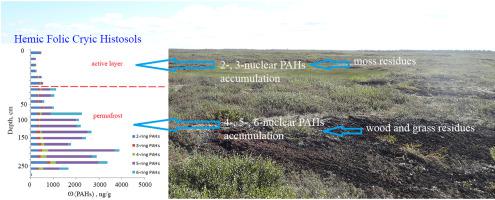当前位置:
X-MOL 学术
›
Appl. Geochem.
›
论文详情
Our official English website, www.x-mol.net, welcomes your
feedback! (Note: you will need to create a separate account there.)
Vertical distribution of PAHs during the evolution of permafrost peatlands of the European arctic zone.
Applied Geochemistry ( IF 3.1 ) Pub Date : 2020-12-01 , DOI: 10.1016/j.apgeochem.2020.104790 Dmitriy Gabov , Evgenia Yakovleva , Roman Vasilevich
Applied Geochemistry ( IF 3.1 ) Pub Date : 2020-12-01 , DOI: 10.1016/j.apgeochem.2020.104790 Dmitriy Gabov , Evgenia Yakovleva , Roman Vasilevich

|
Abstract A range of polycyclic aromatic hydrocarbons has been identified, and regularities of their vertical distribution in the peatland of hummock-hollow complexes in the southern tundra – forest tundra and northern tundra – southern tundra ecotones of the European Arctic zone have been determined. Benzo[ghi]perylene, naphthalene, pyrene, fluorene, phenanthrene, benzo[b]fluoranthene and benzo[a]pyrene are displayed most in the peatlands under study. Regarding the peatland profile the vertical polyarene distribution is similar – in 150–175 cm permafrost layers (site 1) and 50(70)–210(250) cm layers (site 2), and on the border between the active layer and permafrost 35-50(60) cm (site 1) and 30(42) – 50 cm (site 2) a significant increase of HCO-accumulated PAHs weight fraction is observed. PAHs content maximums in tundra peatland horizons are associated both with 4-, 5- and 6-nuclear structures at both sites under the analysis, and with a larger amount of 2- and 3-nuclear polyarenes in the peatlands on the northern tundra-southern tundra ecotone. Aeration-exposed seasonally thawing peatland layers are subject to continuous formation of primarily light 2- and 3-nuclear PAHs of natural origin resulting from microbiological decomposition of plant residues, which are subsequently involved in equilibrium cycles of chemical and biochemical transformation, with their total capacity remaining almost unchanged and constituting ⁓200–500 ng/g. Owing to low productivity of plant communities and absence of tree vegetation in the seasonally thawed layer, accumulation of the sum of 4-, 5- and 6-nuclear PAHs weakens significantly. One can detect dependencies between individual PAHs and the botanic composition of peat through higher weight fraction of 4-, 5- and 6-nuclear polyarenes being lignin transformation products generated more as the share of tree vegetation grows. The PAHs composition is a paleoclimatic marker reflecting adequately both changing paleovegetation stages and the degree of peat decomposition.
中文翻译:

欧洲北极地区多年冻土泥炭地演化过程中多环芳烃的垂直分布。
摘要 已鉴定出一系列多环芳烃,并确定了它们在欧洲北极地区南部苔原-森林苔原和北部苔原-南部苔原交错带丘陵-空心复合体泥炭地的垂直分布规律。苯并[ghi]苝、萘、芘、芴、菲、苯并[b]荧蒽和苯并[a]芘在所研究的泥炭地中含量最多。关于泥炭地剖面,垂直聚芳烃分布相似——在 150–175 cm 永久冻土层(站点 1)和 50(70)–210(250) cm 层(站点 2),以及活动层和永久冻土层之间的边界 35 -50(60) cm(站点 1)和 30(42) – 50 cm(站点 2)观察到 HCO 累积的 PAH 重量分数显着增加。苔原泥炭地层中 PAHs 的含量最大值与所分析的两个地点的 4-、5-和 6-核结构有关,并且与北部苔原-南部泥炭地中大量的 2-和 3-核聚芳烃有关。苔原生态带。曝气暴露的季节性解冻泥炭地层会持续形成主要为自然来源的轻质 2 核和 3 核多环芳烃,这些多环芳烃由植物残留物的微生物分解产生,随后参与化学和生化转化的平衡循环,其总容量几乎保持不变,构成 ⁓200–500 ng/g。由于植物群落生产力低下以及季节性解冻层中没有树木植被,4、5和6核多环芳烃总和的积累显着减弱。人们可以通过更高重量分数的 4-、5- 和 6-核聚芳烃作为木质素转化产物来检测单个多环芳烃与泥炭植物成分之间的依赖性,这些木质素转化产物随着树木植被份额的增长而产生。PAHs 的组成是一个古气候标志,充分反映了古植被阶段的变化和泥炭分解的程度。
更新日期:2020-12-01
中文翻译:

欧洲北极地区多年冻土泥炭地演化过程中多环芳烃的垂直分布。
摘要 已鉴定出一系列多环芳烃,并确定了它们在欧洲北极地区南部苔原-森林苔原和北部苔原-南部苔原交错带丘陵-空心复合体泥炭地的垂直分布规律。苯并[ghi]苝、萘、芘、芴、菲、苯并[b]荧蒽和苯并[a]芘在所研究的泥炭地中含量最多。关于泥炭地剖面,垂直聚芳烃分布相似——在 150–175 cm 永久冻土层(站点 1)和 50(70)–210(250) cm 层(站点 2),以及活动层和永久冻土层之间的边界 35 -50(60) cm(站点 1)和 30(42) – 50 cm(站点 2)观察到 HCO 累积的 PAH 重量分数显着增加。苔原泥炭地层中 PAHs 的含量最大值与所分析的两个地点的 4-、5-和 6-核结构有关,并且与北部苔原-南部泥炭地中大量的 2-和 3-核聚芳烃有关。苔原生态带。曝气暴露的季节性解冻泥炭地层会持续形成主要为自然来源的轻质 2 核和 3 核多环芳烃,这些多环芳烃由植物残留物的微生物分解产生,随后参与化学和生化转化的平衡循环,其总容量几乎保持不变,构成 ⁓200–500 ng/g。由于植物群落生产力低下以及季节性解冻层中没有树木植被,4、5和6核多环芳烃总和的积累显着减弱。人们可以通过更高重量分数的 4-、5- 和 6-核聚芳烃作为木质素转化产物来检测单个多环芳烃与泥炭植物成分之间的依赖性,这些木质素转化产物随着树木植被份额的增长而产生。PAHs 的组成是一个古气候标志,充分反映了古植被阶段的变化和泥炭分解的程度。











































 京公网安备 11010802027423号
京公网安备 11010802027423号